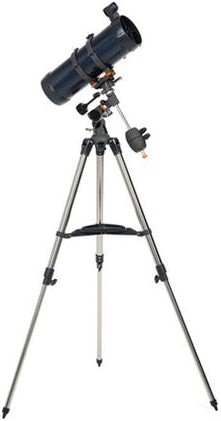
Stargazing is one of the easiest and most affordable hobbies out there. In fact, you can get started without any gear at all, viewing meteor showers, comets, constellations, and the Moon. But the more time you spend looking upward, the deeper into the Universe you want to see. That’s where telescopes come in. Before you know it, your setup can become complicated and expensive. We created this article to give you the Top 10 items you need to keep your telescope kit simple, affordable, and fun. Keep reading—some of our picks might surprise you!
1. Friends and family
Share your love for the night sky with someone. Astronomy is more rewarding when you experience it with others—especially young people. Who knows, you might inspire a future rocket scientist or astronaut!
2. Telescope
From a small tabletop Dobsonian to a monster 14” computerized telescope, there really is a telescope to fit any skill level and budget. Check out our guide on how to buy your first telescope for our tips. If you’ll be using a computerized telescope, make sure to bring along a power supply, too.
3. Low- and high-power eyepieces
Almost all consumer telescopes include two basic eyepieces. You’ll want one with lower magnification (usually around 25mm) and a higher power one when you want a closer view (around 10mm). It can be tempting to experiment with lots of eyepieces, filters, and accessories like Barlow lenses, but stick to these essentials when you’re first starting out—then upgrade to higher quality versions of these same eyepieces.
4. A finderscope
You can’t explore the night sky without a navigator—and that’s why a finderscope is an absolute must-have. Your telescope probably includes one, but consider upgrading to a red dot finder designed exclusively for astronomy like the Telrad or StarPointer Pro. These accessories will help you locate objects faster, so you can view more in one night.
5. Astronomy app or star chart
There are a host of free apps available to help you locate celestial objects and plan your observing session. Our favorite free app is SkyPortal by Celestron.
6. Flashlights
You’ll need two: a red flashlight to preserve your night vision during your viewing session and a bright white one to make cleanup a breeze. If you have a computerized telescope, many external power supplies have these flashlights built right in!
7. Beach towel
We learned this trick years ago from an experienced amateur astronomer. Place a beach towel underneath your telescope’s tripod legs. It provides a clean, soft surface to catch any accessories you might drop in the dark.
8. Binoculars
You get a whole new perspective on the cosmos when you view it through binoculars. Bring a compact, inexpensive model like the Cometron 7x50 astronomy binoculars for a quick glance at your target or for panning the Milky Way. Binoculars are also a great way to entertain people while they aren’t looking through the eyepiece!
9. Astronomer’s toolkit
Keep a small tool kit handy for on-the-spot adjustments. You’ll need a bubble level (if your telescope doesn’t have one built in), a screwdriver, and cleaning supplies like the Zhumell Optic Cleaning Kit or a LensPen.
10. Creature comforts
Celestial events happen throughout the year. If you’re gearing up for summer stargazing, pack along bug spray. If it’s winter, bring chemical or electronic hand warmers and dress in lots of layers. Don’t forget other creature comforts like your favorite tunes and a midnight snack!
Image courtesy Bryan Cogdell, Stellarscapes.net

